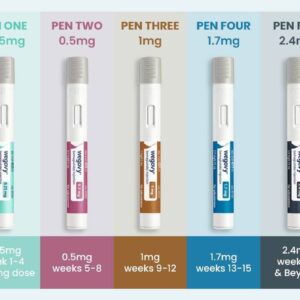Retatrutide: The Next Breakthrough in Weight Loss Treatment?
Retatrutide Weight loss is a challenging journey for many, especially those struggling with obesity or type 2 diabetes. While lifestyle changes like diet and exercise are crucial, sometimes additional help is needed. Enter Retatrutide, a promising new drug that could revolutionize how we approach weight loss.
What Is Retatrutide?.
Retatrutide is an investigational medication designed to help reduce body weight by targeting multiple hormonal pathways. It belongs to a new class of drugs known as “triple agonists,” meaning it activates three different receptors in the body:
-
GLP-1 (Glucagon-like peptide-1) receptor.
-
GIP (Glucose-dependent insulinotropic polypeptide) receptor.
-
Glucagon receptor
By stimulating these receptors, retatrutide helps control appetite, improve blood sugar regulation, and increase energy expenditure, all of which are important for effective and sustained weight loss.
How Does Retatrutide Work?
Each of the three receptors plays a role in metabolism and appetite control:
-
GLP-1: Known for reducing hunger and promoting satiety, GLP-1 also helps regulate blood sugar.
-
GIP: Works alongside GLP-1 to improve insulin response and may enhance fat metabolism.
-
Glucagon: Increases energy use by stimulating the breakdown of fat and raising metabolic rate.
By activating all three, retatrutide offers a multi-pronged approach, potentially providing greater weight loss effects than drugs that target only one receptor.
Clinical Trial Results: Impressive Weight Loss.
Early clinical trials of retatrutide have demonstrated impressive results:
-
Participants lost up to 25-30% of their body weight over several months, significantly more than some current medications.
-
The drug also showed positive effects on blood sugar control, which is beneficial for people with type 2 diabetes.
These results have generated excitement in the medical community, though more extensive studies are ongoing to confirm safety and long-term benefits.
How Does Retatrutide Compare to Existing Treatments?
Current popular weight loss drugs like semaglutide target the GLP-1 receptor alone. While effective, semaglutide typically results in around 15-20% body weight loss. Retatrutide’s triple receptor action could provide an even stronger effect, offering new hope for people who struggle with stubborn weight.
When Will Retatrutide Be Available?
As of now, retatrutide is still undergoing clinical trials and has not yet been approved by regulatory agencies like the FDA. If these trials continue to show positive results, it could become available in the next few years.
Final Thoughts
Retatrutide represents an exciting advancement in weight loss therapy, combining multiple hormonal pathways to tackle obesity more effectively. While it’s not yet widely available, it could change the landscape of weight management in the near future.
If you’re interested in the latest on weight loss treatments or want to explore safe and effective options, stay tuned — the future looks promising!
Retatrutide is an experimental weight loss and diabetes medication currently in development by Eli Lilly. It has gained attention due to remarkable weight loss results in clinical trials, even greater than those seen with semaglutide (Wegovy/Ozempic) and tirzepatide (Mounjaro/Zepbound).
Retatrutide: What is it?
Retatrutide is a triple hormone receptor agonist, meaning it activates three key hormone pathways:
GLP-1 (Glucagon-like peptide-1) – regulates appetite and insulin
GIP (Glucose-dependent insulinotropic polypeptide) – enhances insulin response
Glucagon receptor – helps burn fat and regulate energy.
1. 1 mg every week for the whole study,
2. 2 mg every week for 4 weeks, then 4 mg every week for the rest of the time.
3. 4 mg every week for the whole study.
4. Starting with 2 mg per week, moving to 4 mg, and then 8 mg weekly for most of the study.
5. 4 mg per week for 4 weeks, then 8 mg weekly for the rest of the study.
6. Starting with 2 mg per week, increasing to 4 mg, then 8 mg, with the final dose at 12 mg per week.
The study showed that the more medicine participants took, the greater the weight loss. For example, those on the lowest dose lost about 8.7% of their weight, while those on the highest dose lost 24.2%.
📊 Clinical Trial Results
As of 2023 data:
Average weight loss: up to 24% of body weight over 48 weeks in people with obesity (without diabetes).
This is significantly higher than results seen with:
Semaglutide (Wegovy): ~15%
💊 How It Works
Suppresses appetite.
Increases feelings of fullness.
Enhances fat burning.
Improves insulin sensitivity.
Supports blood sugar control (especially useful for type 2 diabetes)
⚠️ Side Effects.
Common side effects (similar to other GLP-1 drugs):
Nausea
Vomiting
Diarrhea
Constipation
Possible increased heart rate.
It is still in clinical trials and not FDA-approved as of mid-2025.
🕒 When Will It Be Available?
Phase 3 trials are ongoing.
Would you like a comparison between Retatrutide, Wegovy, and Mounjaro, or want to explore natural alternatives for weight loss?
Comparison between Retatrutide, Wegovy, Mounjaro, and Ozempic.
Here’s a comparison of Retatrutide, Wegovy, Mounjaro, and Ozempic — four drugs used primarily for weight loss and the management of type 2 diabetes.
These medications belong to the class of incretin mimetics, which target hormones such as GLP-1, GIP, and glucagon to help regulate appetite, insulin secretion, and glucose levels.
1. Active Ingredient & Mechanism of Action.
Drug Active Ingredient Mechanism of Action.
Retatrutide Retatrutide Triple agonist: GLP-1, GIP, and glucagon receptors.
Wegovy Semaglutide (higher dose) GLP-1 receptor agonist.
Mounjaro Tirzepatide Dual agonist: GLP-1 and GIP receptors.
Ozempic Semaglutide GLP-1 receptor agonist.
2. FDA Approval Status (as of 2025)
Drug Type 2 Diabetes Weight Loss (Obesity/Overweight).
Retatrutide Not yet approved (Phase 3 ongoing) Not yet approved (studies show strong potential).
Wegovy Not indicated ✅ FDA-approved.
Mounjaro ✅ FDA-approved ✅ Approved for weight loss (brand: Zepbound).
Ozempic ✅ FDA-approved ❌ (not approved for weight loss, but used off-label).
3. Efficacy: Average Weight Loss.
Drug Weight Loss (approx.) Notes.
Retatrutide >24% (after 48 weeks, in trials) Most potent so far (2023 Phase 2 data).
Wegovy ~15% 68-week studies in obese adults.
Mounjaro 20–22% Surpasses Wegovy in some trials.
Ozempic ~10–15% Lower doses than Wegovy.
4. Dosing Schedule.
Drug Administration Frequency.
Retatrutide Subcutaneous injection Weekly.
Wegovy Subcutaneous injection Weekly.
Mounjaro Subcutaneous injection Weekly.
Ozempic Subcutaneous injection Weekly.
5. Side Effects
Common side effects (similar across all drugs):
Nausea, vomiting.
Diarrhea or constipation.
Appetite suppression.
Fatigue.
Risk of thyroid C-cell tumors (in rodents)
Additional Notes:
Retatrutide’s glucagon agonism may increase metabolic rate but also cause GI side effects and elevated heart rate.
Mounjaro’s dual action seems better tolerated than GLP-1 alone in some people.
6. Availability & Cost.
Drug Availability Monthly Cost (Est. US).
Retatrutide Clinical trials only Not yet on market.
Wegovy Widely available $1,300+ (before insurance).
Mounjaro Widely available $1,000–$1,300.
Ozempic Widely available $900–$1,200.
7. Summary of Strengths.
Drug Strengths.
Retatrutide Potential best-in-class weight loss; novel triple-agonist.
Wegovy Strong efficacy; approved for weight loss.
Mounjaro High efficacy for both diabetes and weight loss.
Ozempic Effective for diabetes, some weight loss; long track record.
Final Thoughts.
Retatrutide is the most promising based on trial data, especially for obesity, but is not yet approved.
Mounjaro (Tirzepatide) currently offers top-tier weight loss and glucose control, and is now also branded as Zepbound for weight loss.
Wegovy is a strong choice for those without diabetes focused on weight loss.
Ozempic is primarily for diabetes but used off-label for weight loss.
Would you like help choosing between these based on specific goals or health conditions?






Reviews
There are no reviews yet.